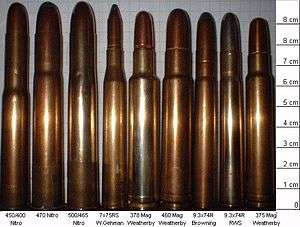.470 Nitro Express
The .470 Nitro Express is a rifle cartridge developed by Joseph Lang in England for dangerous game hunting in Africa and India. This cartridge is used almost exclusively in double rifles. It is in wide use in the Southern and Central-East African region, favoured by hunting guides, primarily while out for hunting Cape buffalo and elephant.
 | ||||||||
| Type | Rifle | |||||||
| Place of origin | England | |||||||
| Production history | ||||||||
| Designer | Joseph Lang | |||||||
| Designed | 1907 | |||||||
| Produced | 1907–present | |||||||
| Specifications | ||||||||
| Parent case | .500 Nitro Express 3¼ in | |||||||
| Case type | Rimmed, bottlenecked | |||||||
| Bullet diameter | .474 in (12.0 mm) | |||||||
| Neck diameter | .504 in (12.8 mm) | |||||||
| Shoulder diameter | .531 in (13.5 mm) | |||||||
| Base diameter | .573 in (14.6 mm) | |||||||
| Rim diameter | .655 in (16.6 mm) | |||||||
| Rim thickness | .040 in (1.0 mm) | |||||||
| Case length | 3.25 in (83 mm) | |||||||
| Overall length | 3.98 in (101 mm) | |||||||
| Case capacity | 146.0 gr H2O (9.46 cm3) | |||||||
| Rifling twist | 1-20 in | |||||||
| Primer type | Boxer | |||||||
| Maximum pressure | 39,160 psi (270.0 MPa) | |||||||
| Ballistic performance | ||||||||
| ||||||||
| Source(s): "Cartridges of the World"[1] | ||||||||
Overview
The .470 NE was originally designed by Lang's as a replacement for the .450 Nitro Express, after the .450 NE was banned in several countries including India. This wasn't because the .450 NE was underpowered or inadequate, but because its bullets could be removed from loaded rounds for use by natives in stolen .577/.450 Martini Henry rifles.[1] Due to the heavy bullet and powder charge, the gun has significant recoil but this is mitigated by the low velocity, resulting in recoil being delivered as a strong push rather than a violent blow. Rifles chambered for this cartridge tend to be heavy double-gun style, and are typically quite expensive.[2]
The .470 NE continues to be the most popular of all the Nitro Express cartridges.[3] Ammunition and components are readily available.[1]
Handloading
Like other 'dangerous game' cartridges, ammunition is expensive compared with standard hunting cartridges, often costing up to 10 times more per shell than typical cartridges such as the .30-06.[4] Because of this many shooters choose to handload the .470 NE.[1] Brass can be obtained from a variety of sources, and like most reloading components varies in quality. Lighter loads for practice can be created that are more enjoyable and cheaper to shoot.[4]
In popular culture
Author and adventurer James S. Gardner provides a realistic, detailed account of the capabilities of a Nitro Express during an ill-fated safari, and again in a graphical account of a desperate firefight against men and a helicopter in his book, The Lion Killer.[5]
See also
- List of rifle cartridges
- 11 mm caliber other cartridges of similar size.
- Nitro Express
References
- Barnes, Frank C. (1997) [1965]. McPherson, M.L. (ed.). Cartridges of the World (8th ed.). DBI Books. pp. 89, 92, 334, 341. ISBN 0-87349-178-5.
- "Twin-Tube Dreamin' Archived 2007-06-02 at the Wayback Machine" by Ted Hatfield, in American Rifleman
- "The .450 Nitro Express" by Charlie Haley
- "An Adventure with Lead Bullets In The .470 Nitro Express Archived 2007-11-07 at the Wayback Machine" by Leo Grizzaffi
- James Gardner (2009). The Lion Killer. Sterling House Pub. ISBN 978-1-56315-462-1.
- Cartridge capacity: Donnelly, John J. (1987). The Handloader's Manual of Cartridge Conversions. Stoeger Publishing. p. 641. ISBN 978-0-88317-269-8.
External links
- .470 Nitro Express
- https://web.archive.org/web/20180123113335/http://www.458express.com/
- Comparing the Big Bores
- "470 Nitro Express load data" from Accurate Reloading
- "The Big Bore Nitro Express Cartridges" by Chuck Hawks
- "470 Nitro Express ballistic data" from Norma
- ".470 Nitro Express history and loading data" from Norma